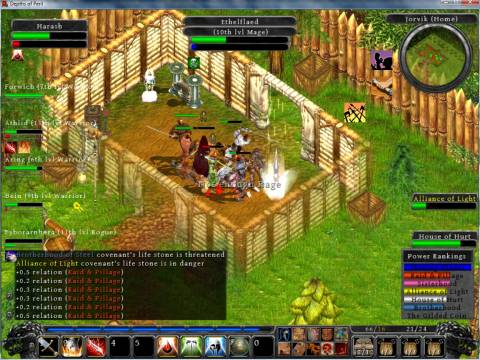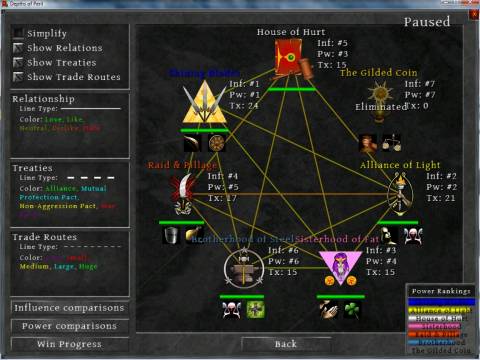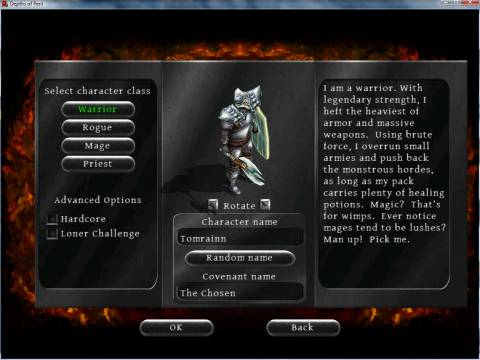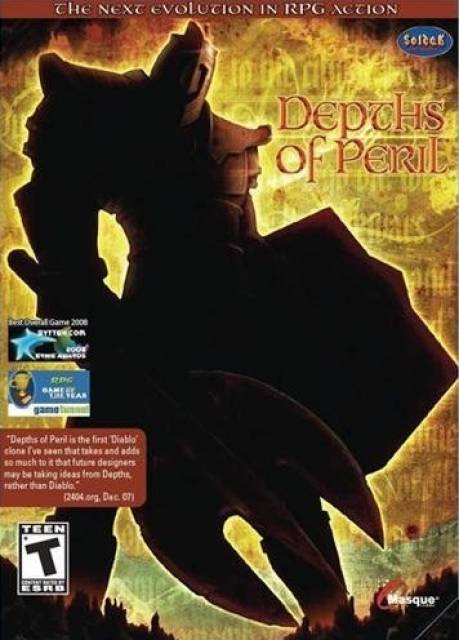Overview
Two primary goals exist for the player:
- to become leader of Jorvik, the barbarian city, and
- to defeat the source of the monster invasion.

To claim leadership over Jorvik, the player must conquer the rival covenants (Peril's term for "clan" or "guild") via military, diplomacy, or a combination of both. A military victory requires the player's covenant to be the last remaining with a charged lifestone. A lifestone uses its energy to revive those whose souls are bound to it, so a lifestone may be drained by repeatedly killing the members of the covenant to whom the lifestone belongs.
Attacking a covenant's house and lifestone is known as a raid. During a raid, both covenants combat each other - continuously reviving - until either lifestone depletes. Once the player has defeated all other covenants in this way, the player is rewarded with a level-scaled reward chest in the center of town. A new option then opens up for the player, allowing him to start a new game but keep all his loot and covenant members.

The military option detailed above should often be combined with diplomacy. Building rapport with other covenants opens up new possibilities, such as:
- trading relations for mutually increased income,
- nonaggression pacts and alliances for protection,
- convincing covenants to attack one another,
- new markets to buy and sell rare items, and
- most practically of all, less covenants attacking the player.
The player gains favor from rival covenants by trade, slaying of mutual rivals, and adventuring together. A diplomatic victory is achieved by sealing alliances with all surviving covenants. If the player's covenant has the most influence in the alliance, victory is automatically granted and the rival members disappear. If, however, the player's covenant is not the strongest, the game does not end. Instead, the player's must gain more influence, pursue a military victory, or accept a partial diplomatic victory with reduced rewards.
During and after the player's interaction with rival covenants, he may also participate in side quests and main quests. Side quests are randomly generated and typically involve item collection and monster slaying. Main quests also involve similar goals, but their contents and the order in which they're offered are the same from game to game. The main quest tells the story of two monster factions, a horde of orcs and a horde of zombies, and their encroachment upon Jorvik and the lands the city protects. Completing quests of either type will result in bonus experience, items, covenant influence, and even new covenant members.
Classes

Four classes are available to the player, each with their own strengths, weaknesses, and skills.
- The warrior excels in dealing and absorbing damage, either of which fill his rage meter for using skills. They have access to the heaviest armors.
- The rogue excels in dealing damage to one unit at a time while also distracting other units to attack something else. Certain skills and critical hits fill her momentum meter for using yet other skills.
- The mage excels in dealing ranged damage to all enemies as well as spells with more exotic effects. This power comes at the cost of reduced hit points and armor.
- The priest excels in healing spells, buffs, and de-buffs. Instead of using mana like the mage, the priest relies on prayer which may only be replenished by using particular skills.
System Requirements
PC
Minimum
- Operating system: Windows 98/2000/XP/Vista
- Processor: 1.2 GHz Pentium 4 (or other equivalent)
- Memory: 128MB RAM
- Hard disk space: 150MB
- Video: GeForce 2 (or other equivalent)
- Sound: DirectX compatible sound card
- DirectX® Version: DirectX 5 or above
Recommended
- Processor: 2.0 GHz Pentium 4 (or other equivalent)
- Memory: 256MB RAM
- Video: GeForce 3 (or other equivalent)
Mac
Minimum
- OS: MAC OS X 10.5.8 or 10.6
- Processor: 1.5 GHz processor
- Memory: 128MB RAM
- Graphics: GeForce 2 (or other equivalent)
- Hard Drive: 150MB of hard drive space
Recommended
- OS: MAC OS X 10.5.8 or 10.6
- Processor: 2.0 GHz processor
- Memory: 256MB RAM
- Graphics: GeForce 3 (or other equivalent)
- Hard Drive: 150MB of hard drive space

 Mac
Mac PC
PC





























